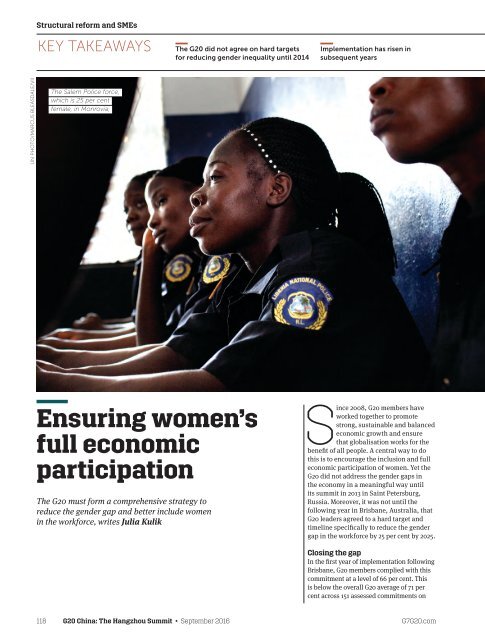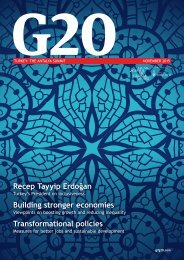G20 china_web
Create successful ePaper yourself
Turn your PDF publications into a flip-book with our unique Google optimized e-Paper software.
Structural reform and SMEs<br />
KEY TAKEAWAYS<br />
The <strong>G20</strong> did not agree on hard targets<br />
for reducing gender inequality until 2014<br />
Implementation has risen in<br />
subsequent years<br />
UN PHOTO/MARCUS BLEASDALE/VII<br />
The Salem Police force,<br />
which is 25 per cent<br />
female, in Monrovia,<br />
Ensuring women’s<br />
full economic<br />
participation<br />
The <strong>G20</strong> must form a comprehensive strategy to<br />
reduce the gender gap and better include women<br />
in the workforce, writes Julia Kulik<br />
Since 2008, <strong>G20</strong> members have<br />
worked together to promote<br />
strong, sustainable and balanced<br />
economic growth and ensure<br />
that globalisation works for the<br />
benefit of all people. A central way to do<br />
this is to encourage the inclusion and full<br />
economic participation of women. Yet the<br />
<strong>G20</strong> did not address the gender gaps in<br />
the economy in a meaningful way until<br />
its summit in 2013 in Saint Petersburg,<br />
Russia. Moreover, it was not until the<br />
following year in Brisbane, Australia, that<br />
<strong>G20</strong> leaders agreed to a hard target and<br />
timeline specifically to reduce the gender<br />
gap in the workforce by 25 per cent by 2025.<br />
Closing the gap<br />
In the first year of implementation following<br />
Brisbane, <strong>G20</strong> members complied with this<br />
commitment at a level of 66 per cent. This<br />
is below the overall <strong>G20</strong> average of 71 per<br />
cent across 151 assessed commitments on<br />
118 <strong>G20</strong> China: The Hangzhou Summit • September 2016 G7<strong>G20</strong>.com
















